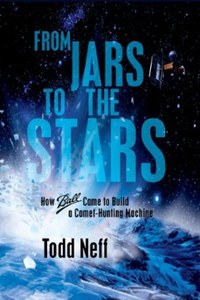Review: From Jars to the Starsby Jeff Foust
|
| The first time around NASA rejected the Deep Impact proposal, ranking it four on a one-to-four scale, meaning, as a Ball executive put it, “Forget it, fellas. Don’t ever propose this again.” |
Neff spends the first third of the book describing just how a company known for jars got into the space business. Those origins date back to the late 1940s and early 1950s, when a group at the University of Colorado got an Air Force contract to develop an instrument to study the Sun at ultraviolet wavelengths that could be flown on sounding rockets, including V-2s captured at the end of the Second World War. Separately, Ed Ball, president of Ball and son of one of the five brothers who founded the company, sought to reinvigorate the company with a research and development arm, acquiring a small company in Boulder, Colorado, that made electronic scales. Within a few years some members of the University of Colorado group left to join the Ball Brothers Research Corporation (later renamed Ball Aerospace and Technologies) as the subsidiary shifted to building instruments and satellites.
After providing the historical background of Ball Aerospace, Neff then dives into the company’s work on the Deep Impact mission. Deep Impact was proposed to NASA by Ball and a team of scientists under the agency’s Discovery program of low-cost planetary science missions. The first time around NASA rejected the proposal, ranking it four on a one-to-four scale, meaning, as a Ball executive put it, “Forget it, fellas. Don’t ever propose this again.” Yet Ball did just that the next time around, retooling the mission and the spacecraft to make the science more compelling and the mission more likely to succeed (in part by giving the impactor a control system so it could steer towards the comet nucleus, reducing the chances it would miss.) This time around Deep Impact made the cut, selected by NASA in 1999 just days after the agency had canceled a lesser-known mission, Space Technology 4, to visit the same comet.
Winning the Discovery competition was only the beginning of the process for Ball, and also the beginning of a long series of trials and tribulations the company and its partner, JPL, experienced trying to build it, expertly described by Neff in the book. Engineers discovered that elements of the spacecraft design included in the proposal wouldn’t work in practice, while other aspects of the spacecraft encountered development issues not atypical for space projects. This led to schedule slips and cost overruns that put the program in jeopardy, as NASA threatened to cancel the mission.
| The reward for doing such missions is, in the end, not financial but something more fundamental: the science obtained from those missions, and the satisfaction of overcoming what at times may have seemed like insurmountable challenges. |
Deep Impact survived those brushes with death, although not without some reshuffling of personnel at Ball and JPL; others put in 80, 100, and even 120 hours a week on the program. (To save money on acoustical testing of the spacecraft, Ball turned to a company whose primary business is providing speakers for concerts. That also helped keep the testing on schedule, as one engineer put it: “if we miss that window of opportunity, Rod Stewart or Hall and Oates have priority over Deep Impact.”) The team that worked on Deep Impact, though, got its reward for all that hard work in the early morning hours of July 4, 2005, when the spacecraft’s impactor hit the nucleus of Tempel 1 and the flyby spacecraft returned dazzling images and other data from the encounter. That flyby spacecraft would go on to perform an extended mission that included a flyby of another comet, Borrelly, last November; another repurposed Discovery-class mission, Stardust, will pay a return visit to Tempel 1 later this month.
One of the themes of From Jars to the Stars is the challenge of building spacecraft designed to do things never done before, like Deep Impact’s mission. Such efforts are not necessarily financially rewarding: Ball effectively gave up its profit on the program to save Deep Impact during one of the times it was threatened with cancellation. Nor are the cost overruns and schedule pressures suffered by Deep Impact unique to it: as Neff recounts, they stretch back not just to the early satellite programs Ball did for NASA in the early 1960s, but even to the University of Colorado instrument work in the 1950s (see also “Space budgets are made to be broken”, The Space Review, December 20, 2010). The reward for doing such missions is, in the end, not financial but something more fundamental: the science obtained from those missions, and the satisfaction of overcoming what at times may have seemed like insurmountable challenges.
